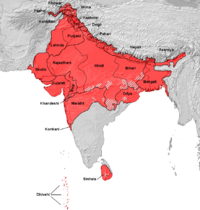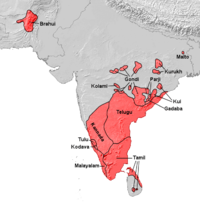- South Asian ethnic groups
-
The ethno-linguistic composition of the population of South Asia, that is the nations of India, Pakistan, Bangladesh, Nepal, Bhutan, Maldives and Sri Lanka is highly diverse. The majority of the population fall within two large Linguistic groups, Indo-Aryan and Dravidian.[1]
These groups are further subdivided into numerous sub-groups, castes and tribes. Indo-Aryans form the predominant ethno-linguistic group in Northern India, Bangladesh, Pakistan, Nepal, Sri Lanka and the Maldives. Dravidians form the predominant ethno-linguistic group in southern India and the northern and eastern regions of Sri Lanka, and a small pocket in Pakistan. Iranian peoples, grouped with Indo-Aryans in the Indo-Iranian language group, also have a significant presence in South Asia, the large majority of whom are located in Pakistan, with heavy concentrations in Balochistan, Khyber-Pakhtunkhwa and Federally Administered Tribal Areas. Dardic peoples form a minority among the Indo-Aryans. They are classified as belonging to the Indo-Aryan language group,[2] though sometimes they are also classified as external to the Indo-Aryan branch.[3] They are found in northern Pakistan (Northern Areas and Khyber-Pakhtunkhwa) and in Jammu and Kashmir, India.
Minority groups not falling within either large group mostly belong to the Austro-Asiatic and Tibeto-Burman language families, most of whom live around North-East India, Nepal, and the Chittagong Division of Bangladesh. The Andamanese (Sentinel, Onge, Jarawa, Great Andamanese) live on some of the Andaman Islands and speak a language isolate, as do the Kusunda in central Nepal,[4] the Vedda in Sri Lanka, and the Nihali of central India, who number about 5000 people. The people of the Hunza valley in Pakistan are another distinct population. They speak Burushaski, a language isolate.
The traditions of different ethnic groups in South Asia have diverged, influenced by external cultures, especially in the northwestern parts of South Asia (where Turkic and Iranian peoples have had much influence) and in the border regions and busy ports, where there are greater levels of contact with external cultures. This is particularly true for many ethnic groups in the northeastern parts of South Asia who are ethnically and culturally related to peoples of the Far East. The largest ethno-linguistic group in South Asia are the Indo-Aryans, numbering around 1 billion, and the largest sub-group are the native speakers of Hindi languages, numbering more than 470 million.
Contents
List of ethnic groups on the basis of language
Indo-Aryan
People who speak an Indo-Aryan language.
Most of the North Indian population is of Indo-Aryan descent. The Ra1a1 gene haplotype is found in at least 50% of the populations from North/East India to Central Asia and Eastern Europe.
- Assamese people (i.e. the Assamese speakers of the Brahmaputra valley, not to be confused with the multi-ethnic people of Assam)[5]
- Parsi people
- Bengali people
- Bihari people
- Dhivehi people
- Gujarati people
- Saurashtra people
- Hindkis
- Hindkowans
- julaha
- Konkani people
- Marathi people
- Mers
- Muhajir people
- Bihari Muslim
- Oriya people
- Paharis
- Punjabi people
- Khatri people
- Jatt people
- Kamboj/Kamboh
- Punjabi Rajput
- Punjabi Shaikh
- Haral
- Dogar
- Tarkhan people
- Labana
- Khattar
- Awan
- Mughal (tribe)
- Arain
- Rajasthanis
- Seraikis
- Sinhalese people
- Sindhi people
- Tharu people
Iranian peoples
- Balochi people
- Hazaras
- Pashtun people
- Lohani (Pashtun ethnic group)
- Tajik people
Dardic peoples
Note: The Dardic languages are largely seen as Indo-Aryan, but are sometimes seen as a separate Indo-Iranian branch.
Dravidian peoples
- Bhil
- Bonda
- Brahui people
- Kurukh (Oraon)
- Dongria Kondha
- Khonds
- Gondi people
- Kannadigas
- Badagas
- Kannadigas
- Kodava
- Malayalis
- Native Hindus
- Mappilas
- Cochin Jews
- Syrian Malabar Nasrani
- Malto people
- Tamil people
- Indian Tamils
- Sri Lankan Tamils
- Telugu people
- Toda people
- Tuluvas
- Irulas
Austro-Asiatic peoples
- Munda people
- Khasi people
- Nicobarese people
Tibeto-Burman peoples
 Red: Sino-Tibetan languages Light green: Indo-European languages Blue: Dravidian languages Dark Green: Altaic Languages Grey: 3 groups; Japonic {possibly Altaic}, Koreanic, {possibly Altaic}, and Indochinese languages Pink: Austronesian languages Dark Pink: Austro-Asiatic languages.
Red: Sino-Tibetan languages Light green: Indo-European languages Blue: Dravidian languages Dark Green: Altaic Languages Grey: 3 groups; Japonic {possibly Altaic}, Koreanic, {possibly Altaic}, and Indochinese languages Pink: Austronesian languages Dark Pink: Austro-Asiatic languages.
- Tibetans and Tibetan-speaking speaking peoples
- Bhutias
- Bhotiyas
- Sherpas
- Tibetan Ladakhis
- Monpa
- Takpa
- Tshangla
- Sherdukpen
- Aka
- Miji
- Tibetan Muslim
- Chakma
- Chepang
- Gurung
- Karbi people or Mikir
- Kirat people
- Lepcha people
- Magar people
- Manipuri or Meithei people
- Naga people
- Newar people
- Tamang
- Thakali
- Thami
- Tripuris
- Memba
- Khowa
- Nishi
Turko-Mongol peoples
- Turkish Indian
- Mughal (Moghul)
- Hazaras (Turko-Mongol origins, but Iranian language)
- possibly Hunza (may be related to Yenisei Siberians[citation needed])
Austronesian peoples
Semitic peoples
- Indian Jews
- Cochin Jews (Malayali Jews)
- Bene Israel (Marathi Jews)
- Baghdadi Jews (Arab Jews in Bengal)
- Bnei Menashe (Mizo and Kuki Jews)
- Bene Ephraim (Telugu Jews)
- Syrian Malabar Nasranis are descendents of both Hindu and Jewish converts to Christianity
- Knanaya(a sub-group of Syrian Malabar Nasranis)
- Paradesi Jews (European Jews in India)
- Arabs or mixed Arab and Indo-Aryan or Dravidian
- Iranian Arabians
- Konkani Muslims (trace ancestry to Arab traders on the west coast of India)
- Mappila (only a minority of the Mappila population, trace ancestry to Arab traders in the State of Kerala, India)
- Sri Lankan Moors ( trace ancestry to Arab traders who settled in Sri Lanka)
- Muhajirs
- Iraqi biradri A community of Muslims in north India
- Deccan A community of Muslims in Southern and Northern parts of the Deccan Plateau such as Hyderabadi Muslims
- Labbay Arab traders who settled in South India (trace ancestry back to Egyptian traders)
- Memons Possibly the earliest Muslims to arrive in India,(trace ancestry to Syrians who came with Muhammad Bin Qasim) during the expedition of Sindh.
- Boras Trace ancestors to Arab traders and Merchants.
- Chaush Trace ancestors to traders from Yemen
- Punjabi Shaikhs Dawah workers that arrived in India
Tai peoples
- Ahom people
- Tai Aiton
- Tai Khampti
- Tai Phake or Tai Phakial
- Tai Turung
European/Eurasian peoples
- Anglo-Burmese
- Anglo-Indian
- Burgher people
Afro-Asian
- African Pakistani
- Black Jews of Kerala
- Great Andamanese of the Andaman and Nicobar Islands
- Jangil of the Andaman and Nicobar Islands
- Jarawa of the Andaman and Nicobar Islands
- Onge of the Andaman and Nicobar Islands
- Sentinelese of the Andaman and Nicobar Islands
- Sheedis/Siddis, an ethnic community of Black African descent
- Siddi
- Siddis of Karnataka, an ethnic community of Black African descent
- Sri Lanka Kaffirs
Linguistically isolate groups
- Andamanese
- Hunza people
- Kusunda
- Nahali (Kalto)
- Vedda
Diaspora
Many South Asian ethnic groups and nationalities have substantial diasporas outside of South Asia.
- South Asian American
- South Asian Canadian
- Indo-Canadian
- Pakistani Canadian
- Sri Lankan Canadian
- Tamil Canadian
- Bangladeshi Canadian
- British Asian
- British Indian
- British Pakistani
- British Bangladeshi
- British Tamil
- Sri Lankans in the United Kingdom
- Nepalis in the United Kingdom
- British Indo-Caribbean community
- Mauritians in the United Kingdom
- Asian-Scots
- South Asian Australian
- Indian Australian
- Pakistani Australian
- Sri Lankan Australian
- Bangladeshi Australian
- Indo Kiwi
- Indians in Singapore
- Malaysian Indian
- Indian Indonesian
- Indo-Mauritian
- Bihari Mauritian
- Indo-Caribbean
- Burmese Indians
- South Asians in Hong Kong
- South Asians in the Philippines
- Indians in Germany
- Indian South Africans
- Indians in Botswana
- Indians in Kenya
- Indians in Madagascar
- Indo-Mauritian
- Indians in Mozambique
- Indo-Réunionnaise
- Indo-Seychellois
- Indians in Tanzania
- Indians in Uganda
- Indians in Zambia
- Indians in Zimbabwe
- Indians in Iran
- Indians in Thailand
- Indians in the United Arab Emirates
- Indians in Vietnam
- Indians in Barbados
- Indians in Belize
- Indo-Guyanese
- Indo-Grenadians
- Indians in Guadeloupe
- Indians in Panama
- Indians in Belgium
- Indian diaspora in France
- Indians in Israel
- Indians in Italy
- Indians in Portugal
- Indian community in Spain
- Indo-Fijian
- Indians in New Caledonia
- Hindoestanen
See also Punjabi diaspora, Bangladeshi diaspora, Tamil diaspora, Pakistani diaspora, Sri Lankan Tamil diaspora and Indian diaspora.
Two (or possibly three) other people groups have ethnic and linguistic ties with the region:
- Dom people
- Romani people
- Lom people (who speak a language both related to Indo-Aryan and Armenian)
See also
- Languages of South Asia
- Genetics and Archaeogenetics of South Asia
- Y-DNA haplogroups in South Asian populations
- Historical definitions of races in India
- Languages of India
- Scheduled castes and scheduled tribes
- Indian diaspora
- Pakistani diaspora
- Desi
- Languages of Pakistan
- Ethnic groups in Pakistan
- Assamese people
- Sikkimese people
National demographics:
- Demographics of Afghanistan
- Demographics of Bangladesh
- Demographics of Bhutan
- Demographics of India
- Demographics of Iran
- Demographics of Maldives
- Demographics of Burma
- Demographics of Nepal
- Demographics of Pakistan
- Demographics of Sri Lanka
References
- ^ According to https://www.cia.gov/library/publications/the-world-factbook/region/region_sas.html (retrieved on October 2010), 98% of the population of Bengladesh are Bengali (Indo-Aryan), 72% of the population of India are Indo-Aryan and 25% are Dravidian, 44.68% of the population of Pakistan are Punjabi and 14.1% are Sindhi (two Indo-Aryan populations), and 73.8% of the population of Sri Lanka are Sinhalese (Indo-Aryan). Given the fact that India, Pakistan, Bengladesh and Sri Lanka represent a huge mass of population (1 508 851 998) compared to Afghanistan, Buthan, Nepal and the Maldives (58 051 568), the majority of the population of South Asia are Indo-Aryan or Dravidian. Moreover, Nepal and Bhutan probably have an important part of their populations which are also Indo-Aryan. Feel free to check.
- ^ G. Morgenstierne Irano-Dardica. Wiesbaden 1973; Morgenstierne, G. Indo-Iranian frontier languages. (Instituttet for Sammenlignende Kulturforskning. Publ. ser. B: Skrifter, no. 11, 35, 40) Oslo: H. Aschehoug, 1929 sqq, reprint Oslo 1973,C. Masica The Indo-Aryan languages, New York 1991, p. 21; R.L. Trail and G.R. Cooper, Kalasha Dictionary, Islamabad & High Wycombe 1999 p. xi; The Indo-Aryan languages, edited by George Cardona and Dhanesh Jain. London, New York : Routledge, 2003
- ^ G.A. Grierson, The Pisaca Languages of North-Western India,Asiatic Society, London, 1906, repr. Delhi 1969, p. 4-6; still repeated in: History of Civilizations of Central Asia, Ahmad Hasan Dani, Vadim Mikhaĭlovich Masson, János Harmatta, Boris Abramovich Litvinovskiĭ, Clifford, 1999
- ^ D.E. Watters, Notes on Kusunda (a language isolate of Nepal), Kathmandu 2005
- ^ Yasmin Saikia. Fragmented Memories. http://books.google.com/books?id=p9PkFF3uq_8C&pg=PA5&d.
Ethnicity Related concepts Clan · Ethnic group · Ethno-linguistic group · Ethno-religious group · Indigenous peoples · Meta-ethnicity · Minority group · Nation · Nationality · Panethnicity · Population · Race · TribeEthnology Ethnic groups by region Africa (Arab League) · America (Indigenous · Canada · United States · Central America · South America) · Asia (Central Asia · East Asia · Northern Asia · South Asia · Southeast Asia · West Asia) · Australia (Indigenous) · Europe · Oceania (Indigenous · European)Identity and ethnogenesis Multiethnic society Ideology and ethnic conflict Categories:- Ethnic groups in Pakistan
- Ethnic groups in India
- Ethnic groups in South Asia
Wikimedia Foundation. 2010.



